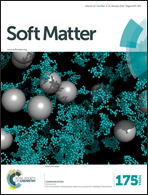MPTTF-containing tripeptide-based organogels: receptor for 2,4,6-trinitrophenol and multiple stimuli-responsive properties†
Abstract
A series of monopyrrolotetrathiafulvalene–tripeptide conjugates have been synthesized and investigated as new low-molecular mass organogelators. It was found that most of these compounds could immobilize low-polarity solvents readily and the gelation behaviors of these gelators showed a dependence on the amino acid residues. These organogels were thoroughly studied using various techniques including atomic force microscopy (AFM), field-emission scanning electron microscopy (FE-SEM), circular dichroism (CD) spectroscopy, Fourier-transform infrared (FT-IR) spectroscopy, 1H NMR spectroscopy, UV-Vis absorption spectroscopy and X-ray diffraction (XRD). The results showed that the cooperative interplay of hydrogen bonding, π–π stacking and S⋯S interactions were the main driving force for the formation of the gels. Of all the organogels, the aromatic solvent gels, such as toluene gel, exhibited multiple-stimulus responsiveness towards heating, shaking, chemical redox activity and the presence of anions, thus leading to reversible sol–gel phase transitions. Most interestingly, gelation in the presence of 2,4,6-trinitrophenol (TNP) in organic solvents could be observed visually with a concomitant color change through donor–acceptor interactions. The strength of the charge-transfer interaction between gelators and TNP was proportional to the incubation time and increasing critical gelation concentration (CGC). The gels could function as efficient absorbents for potential application in removal of crystal violet and rhodamine B dyes from water.


 Please wait while we load your content...
Please wait while we load your content...